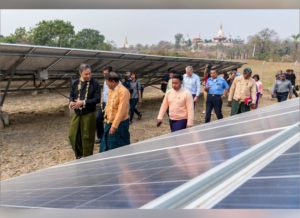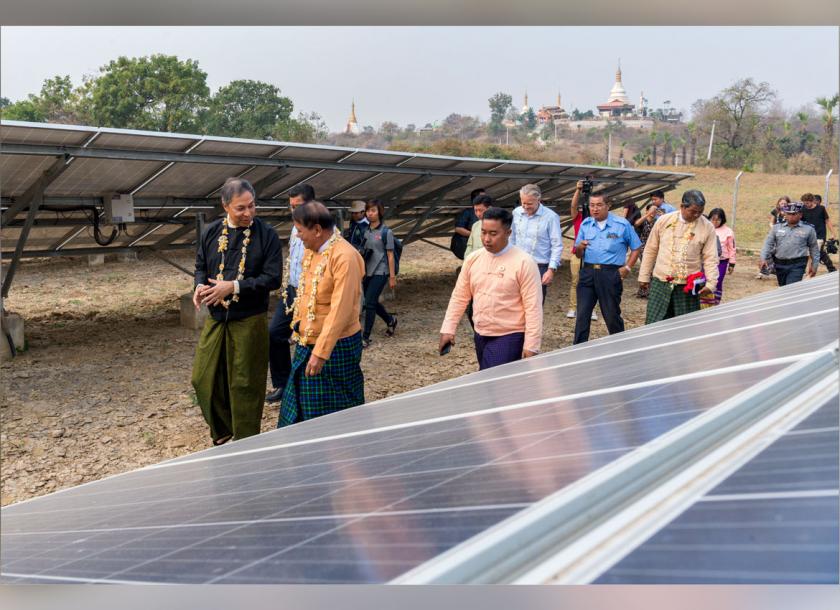
Solar power gains ground in Sagaing, Myanmar
A Norwegian fund-backed joint venture with Yoma Strategic has completed installing US$28 million worth of plants harnessing energy from the sun to generate electricity for Myanmar communities in remote areas.
In Sagaing Region, Yoma Micro Power this month launched its 250th off-grid solar plant in Thint Sein Gyi village of Wetlet township. The $100,000 plant has a peak capacity of 31.2 kilowatt, providing power supply to around 1000 villagers.
The expansion of mini-grids reflects the investment potential of renewable sources in Myanmar as the Southeast Asian country seeks to fill its energy deficit while battling climate change.
Yoma Micro Power’s target is to scale up to 750 plants this year and over 2000 plants by 2022, totaling $200 million. With over 60 percent of Myanmar’s rural population cut off from the national grid, there is a huge market to tap into.
Norwegian development body Norfund, the World Bank’s International Finance Corporation and Singapore-listed Yoma Strategic formed the company with CEO Alakesh Chetia. It has so far materialised $28 million investments in those 250 plants.
The Myanmar Times travelled to Thint Sein Gyi in a media trip to look at this particular $100,000 infrastructure. The solar units, backed up by diesel, were built over 70 days.
“Everything in my daily life has become more convenient for me after having access to electricity, and stable power supply helps the village to develop immensely,” said villager Daw Aye Thein.
Solar is not only more environmentally friendly than fossil fuel, this particular plant also provides electricity at a price lower than diesel generators.
Every solar mini-grid by Yoma Micro Power is paired with at least one local villager who serves as the “caretaker” of the infrastructure, responding to technical hitches.
“Working for Yoma Micro Power has helped me tremendously in terms of finance because I wasn’t able to support my whole family previously as a farmer,” said caretaker U Myint Ko.
The government under Daw Aung San Suu Kyi is expanding the national grid to the rest of the population, the majority of which are still not connected. But Myanmar’s varied and complex topography means the grid will likely not arrive in the archipelagoes and mountainous areas until a number of years or even a decade. Meanwhile, communities in these remote regions can access safe and reliable power supply through decentralised mini-grids.
The industry’s prospects have significantly improved for big solar grid-projects too, as the cost of generating electricity from panels has become more affordable than gas-fired plants with the increase in electricity tariffs last year.
Among the encouraging signs for the mini-grid industry were the recent projects launched by local firm Parami Energy and Mandalay Yoma in Magway Region.
The fact that solar technology is easily expandable makes it an attractive proposition to cope with rising demand from villages, said CEO Alakesh Chetia.
“Solar is a modular technology. Over time as demand grows, we can keep adding more panels,” he told The Myanmar Times, adding that his firm’s plants are compatible with the national grid. It also enables Yoma Micro Power to build a mini-grid system in a matter of two weeks now from two months before, he added.
Over 60 percent of his firm’s projects are located in Sagaing, underscoring the Sagaing government’s commitment to improve electricity access for communities across the area.
“The Sagaing regional government has been trying their best in electrification via solar and hydropower projects, and has since invested K24 billion in power generation, or K6 billion each year,” the regional electricity minister U Than Nyunt Win told this newspaper.
Energy project proposals involving 30 megawatts or less only require the approval of the sub-national government, and the construction timeline usually takes as short as a few weeks to half a year, according to the Yoma Micro Power.
Its pilot project in Sagaing was approved immediately in 2017 with the support of the regional government.
“For some other regional governments, it could take anywhere from two-three months to perhaps even four to six months,” Mr Chetia said.
Source: https://www.mmtimes.com/news/solar-power-gains-ground-sagaing.html
